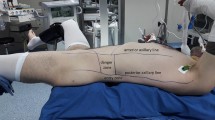Abstract
Purpose
To compare percutaneous nephrolithotomy (PCNL) safety and efficacy in prone, supine, and flank positions.
Methods
A total number of 150 candidates for PCNL were randomly assigned into prone, supine, and flank groups. Patients in groups 1 and 2 underwent fluoroscopy-guided PCNL in prone and supine positions, respectively, while patients in group 3 underwent ultrasonography-guided PCNL in lateral position.
Results
The success rates were 92, 86, and 88 % in prone, supine, and flank positions, respectively (P = 0.7). The mean access duration was 6.9 ± 4.2, 11.1 ± 5.8, and 10.8 ± 4.1 min (P = 0.08), and the mean operation time was 68.7 ± 37.4, 54.2 ± 25.1 and 74.4 ± 26.9 min (P = 0.04) in prone, supine, and flank groups, respectively. Pyelocaliceal perforation occurred in 2 (4 %), 2 (4 %), and 3 (6 %) patients in prone, supine, and flank positions, respectively (P = 1).
Conclusion
We believe that PCNL in both supine and flank positions are as safe and relatively effective as prone position in experienced hands. Preference of the surgeon and proper case selection for each procedure is very important and necessary.

Similar content being viewed by others
References
Goodwin WE, Casey WC, Woolf W (1955) Percutaneous trocar (needle) nephrostomy in hydronephrosis. J Am Med Assoc 157(11):891–894
Fernstrom I, Johansson B (1976) Percutaneous pyelolithotomy. A new extraction technique. Scand J Urol Nephrol 10(3):257–259
Tiselius HG, Ackermann D, Alken P et al (2008) EAU guidelines on urolithiasis. Arnhem, the Netherlands: European Association of Urology
Preminger GM, Assimos DG, Lingeman JE et al (2005) AUA guideline on management of staghorn calculi: diagnosis and treatment recommendations. J Urol 173:1991–2000
Karami H, Arbab AH, Rezaei A et al (2009) Percutaneous nephrolithotomy with ultrasonography-guided renal access in the lateral decubitus flank position. J Endourol 23(1):33–35
Valdivia Uria JG, Valle Gerhold J, Lopez Lopez JA et al (1998) Technique and complications of percutaneous nephroscopy: experience with 557 patients in the supine position. J Urol 160:1975–1978
Falahatkar S, Asli MM, Emadi SA et al (2011) Complete supine percutaneous nephrolithotomy (csPCNL) in patients with and without a history of stone surgery: safety and effectiveness of csPCNL. Urol Res 39(4):295–301
Gofrit ON, Shapiro A, Donchin Y et al (2002) Lateral decubitus position for percutaneous nephrolithotripsy in the morbidly obese or kyphotic patient. J Endourol 16:383–386
Kerbl K, Clayman RV, Chandhoke PS, Urban DA, De Leo BC, Carbone JM (1994) Percutaneous stone removal with the patient in a flank position. J Urol 151(3):686–688
Karami H, Rezaei A, Mohammadhosseini M et al (2010) Ultrasonography-guided percutaneous nephrolithotomy in the flank position versus fluoroscopy-guided percutaneous nephrolithotomy in the prone position: a comparative study. J Endourol 24(8):1357–1361
Autorino R, Giannarini G (2008) Prone or supine: is this the question? Eur Urol 54(6):1216–1218
Wu P, Wang L, Wang K (2011) Supine versus prone position in percutaneous nephrolithotomy for kidney calculi: a meta-analysis. Int Urol Nephrol 43(1):67–77
Edgcombe H, Carter K, Yarrow S (2008) Anaesthesia in the prone position. Br J Anaesth 100(2):165–183
Backofen J (1985) Hemodynamic changes with prone positioning during general anesthesia. Anesth Analg 64:194
Atkinson CJ, Turney BW, Noble JG et al (2011) Supine vs prone percutaneous nephrolithotomy: an anaesthetist’s view. BJU Int 108(3):306–308
Rana AM, Bhojwani JP, Junejo NN et al (2008) Tubeless PCNL with patient in supine position: procedure for all seasons?–with comprehensive technique. Urology 71(4):581–585
Duty B, Okhunov Z, Smith A et al (2011) The debate over percutaneous nephrolithotomy positioning: a comprehensive review. J Urol 186(1):20–25
Scoffone CM, Cracco CM, Cossu M et al (2008) Endoscopic combined intrarenal surgery in Galdakao-modified supine Valdivia position: a new standard for percutaneous nephrolithotomy? Eur Urol 54:1393–1403
Miano R, Scoffone C, De Nunzio C et al (2010) Position: prone or supine is the issue of percutaneous nephrolithotomy. J Endourol 24(6):931–938
Liu L, Zheng S, Xu Y et al (2010) Systematic review and meta-analysis of percutaneous nephrolithotomy for patients in the supine versus prone position. J Endourol 24(12):1941–1946
De Sio M, Autorino R, Quarto G et al (2008) Modified supine versus prone position in percutaneous nephrolithotomy for renal stones treatable with a single percutaneous access: a prospective randomized trial. Eur Urol 54(1):196–202
Falahatkar S, Moghaddam AA, Salehi M et al (2008) Complete supine percutaneous nephrolithotripsy comparison with the prone standard technique. J Endourol 22(11):2513–2517
Manikandan S, Umamaheswara Rao GS (2002) Effect of surgical position on pulmonary gas exchange in neurosurgical patients. Indian J Anaesth 46:356–359
Basiri A, Ziaee SA, Nasseh H et al (2008) Totally ultrasonography-guided percutaneous nephrolithotomy in the flank position. J Endourol 22(7):1453–1457
Conflict of interest
The authors declare that they have no conflict of interest.
Author information
Authors and Affiliations
Corresponding author
Rights and permissions
About this article
Cite this article
Karami, H., Mohammadi, R. & Lotfi, B. A study on comparative outcomes of percutaneous nephrolithotomy in prone, supine, and flank positions. World J Urol 31, 1225–1230 (2013). https://doi.org/10.1007/s00345-012-0889-y
Received:
Accepted:
Published:
Issue Date:
DOI: https://doi.org/10.1007/s00345-012-0889-y




